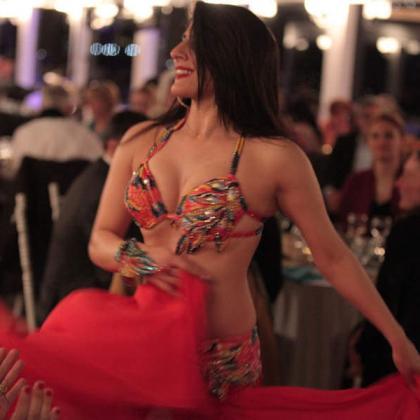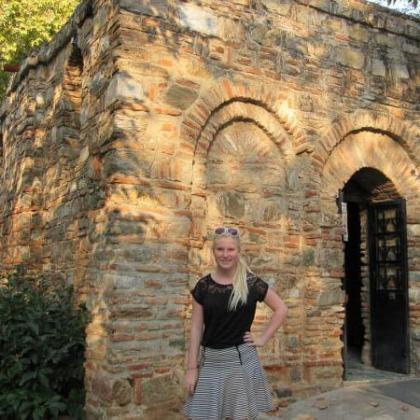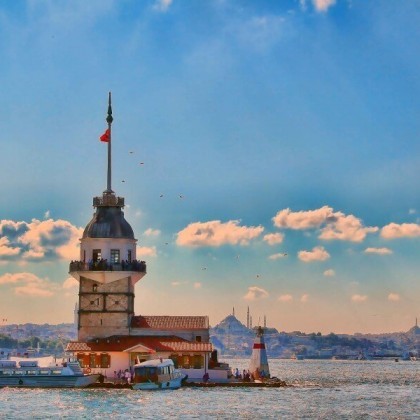Erzincan
Erzincan lies in the fertile Euphrates River valley, surrounded by wildflowers and poplar groves and bordered by the Munzur range to the south and the Western extensions of the Kaçkars to the north. An ancient city robbed of its quaintness by a series of natural disasters, Erzincan has quickly rebuilt itself: in 1939, it suffered one of the most devastating earthquakes in Turkish history, which killed more than 30,000 people. A later quake in 1993 (plus a few in between) destroyed most of the buildings of historical interest. The town, however, has recovered rapidly, and commercial and civil industry are booming throughout the downtown area. Students from all over Turkey attend Erzincan’s Atatürk University, lending the town a vibrant and somewhat cosmopolitan air. A clean and energetic town, Erzincan is an ideal base for exploring the natural beauty of the upper Euphrates valley.
Istanbul New Year’s Eve Party Cruise on the Bosphorus
IstanbulWith this new year's eve party program in Istanbul, you will have an amazing new year party on the Bosphorus. Book it now and don't miss the special price!
View Tour3 Days Ephesus, Pergamon and Pamukkale Tour Package
Ephesus, Pamukkale, PergamonIf you want to make an amazing trip to the Ephesus, Pergamon, and Pamukkale, you should read our tour itinerary.
View TourIstanbul and Cappadocia Tour – 7 Days
Istanbul, Cappadocia, TurkeyIf you want to make a trip to Istanbul and Cappadocia both, we strongly suggest you join this amazing package tour. This tour covers all the accommodations, transportations, lunches...
View TourBest of Turkey Package Tour – 8 Days
Istanbul, Cappadocia, Ephesus, PamukkaleAre you looking for a good traveling package in Turkey? With our 8-days Turkey tour, you will make a trip to every important sight in Turkey. Enquire now for...
View TourTRANSPORTATION
The otogar is at the far eastern end of town, where Fevzıpaşa Cad. meets the highway. This small, new station boasts a tiny PTT and connections to almost everywhere in Turkey. Buses travel to: Adana (Turay, 12hr., 4pm, $11); Ankara (Dadaş; 11hr., 10:30am, 1pm; $17); Bodrum (Palandökken, 23hr., 7:30pm, $28); Diyarbakır (Turay, 14hr., 12:30pm, $17); Erzurum (Esadas, 3hr., 6 per day 10am-4:30pm, $4); Gaziantep (Turay, 12hr., 11:30pm, $16); İstanbul (Dadaş, löhr., 4pm, $20); Kayseri (Turay, 6hr., 4pm, $19); Konya (Palandökken, 11hr., 7:30pm, $18); Malatya (Turay; 7hr.; 12:30pm, 11pm, $17); Şanliurfa (Turay, 14hr., 11:30pm, $19); Sivas (Yes; 4hr.; 1,4, 8pm; $4). Dolmuş and minibuses leave from the dolmuş stop diagonally opposite the otogar. This is the best way to get to Altintepe ($.20 each way) and other local destinations. The train station, midway between Sivas and Erzurum on the Ankara line, is on the southernmost end of Şubat Cad. One train runs daily in each direction.
ORIENTATION AND PRACTICAL INFORMATION
Erzincan’s center is an open pavilion, from which spread Fevzıpaşa Cad. to the east, Ordu Cad. to the north, Halitpaşa Cad. to the west, and Şubat Cad. to the south. Traveler services, including 24hr. police, ATMs, and internet cafes can be found near the intersection of these four streets. The otogar is on the easternmost end of Fevzıpaşa Cad., and the two blocks between the otogar and the town center contain the best hotels and restaurants. The north end of the central pavilion hosts the Erzincan Museum and the Gemi İs Merkezi, an unusual ocean-liner-shaped civic center popular with students. Atatürk University is 1km north on Ordu Cad. The tourist office, 19 Fevsıpaşa Cad. ( 223 37 92), is in an alley across from Pamuk Bank near the central pavilion on the third floor. Doğa Sporları Derneği ( 224 24 42) is housed in Elektric Market No. 113 in the Kızılay Işhani building at the Conner of Fevzıpaşa Cad. and Şurat Cad. Ask for Rifat Ekinci; he can organize climbing, rafting, sküng, and biking trips. Grocery stores line Halitpaşa Cad. The PTT is two blocks north of the pavilion on Ordu Cad. (Open M-Sa 7am-11pm.) Postal code: 24000.
ACCOMMODATIONS
Many hotels have sprouted up on the two-block stretch of Fevzipaşa Cad. The following hotels are all close to the otogar, and all offer more or less the same amenities, including TV7 and hot water showers. Otel Karakaya , 40B Fevzipaşa Cad., boasts a lounge with a fish tank and plush furniture. It’s clean, comfortable, quiet, and cheap. (214 36 73. Singles $6, doubles $10, triples $14.) For a little extra, try the new Hotel Hanedan , 34/B Fevzipaşa Cad. (224 24 04. Singles $9; doubles $11.) The Yeni Kiliçar Oteli, 41 Fevzıpaşa Cad. (223 13 80), is dark but clean arid well-priced, and Kervan Otel , 96 Fevsıpaşa Cad. ( 214 13 64; fax 224 14 13) is closest to the otogar, with the same prices. (Singles $4, with bath $8; doubles $8, with bath $10; triples $9, with bath $12.)
FOOD
Erzincan offers little in the way of haute cuisine, but dozens of kebapgis and salonus line Fevzipaşa Cad. The clean and well it Evin Kevser , 14A Fevzıpaşa. Cad. offers decent roasted vegetables in addition to kebaps and lahmecuns, and features a fountain full of small turtles. (212 23 90. Meal $1-3. Open until 10pm.) The Derya Restoran, 21/C Fevzipaşa Cad. (223 77 17), offers similar fare until midnight. Popular Sariyer Işkende Salonu, 18A Halitpaşa Cad. (224 04 36), on the other side of the pavilion, is cheerful and open 24hr. For a step up, Beyaz Saray O, Vakitler İshani Kat No. 1 (224 44 31), on the eastern side of Ordu Cad., offers a more refined atmosphere and particularly flavorful merkeci (lentil soup) at bargain prices ($2-4 for a full meal). Of Erzincan’s many çay salonu, the pillowed and carpeted cave of the Cafe Çapari, located on the south mezzanine of the Gemi Is Merkezi are, is popular with students. What little nightlife Erzincan offers can be found at a few dry discos such as the Mobidik Cafe, 29 Hükümet Cad., across from the western side of the Gemi Is Merkezi, where you can dance to halay and Euro pop under a single disco ball until about 11pm.
SIGHTS
ALTINTEPE
“The Golden Hill,” is an important Urartian site, discovered in 1938 during the construction of the eastern portion of the Turkish railroad (see From Hittites to Hellenes). Believed to have been constructed between the 7lh and 8th centuries BC , Altintepe was once a substantial palace and temple. Resist the taxi temptation and take a $.40 dolmuş from diagonally opposite the otogar. To climb to the ruins from the dolmuş drop-off, you must first cross an irrigation canal intermittently guarded by Sivas Cangol sheepdogs, then circle around to the back side of the mound to find a climbable aspect. The 5min. ascent offers the intrepid a magnificent view of the Euphrates valley from battlements, platforms, and tumbled columns. On the way back, visit the hot springs at Ekşisu, where cirit is played most Sundays in the spring and summer
THE ERZINCAN MUSEUM
located in the center of the pavilion, is an elegant high- ceilinged affair bedecked with photographs of the city before the catastrophic 1939 earthquake. Look for the spry octogenarian Mustafa Nçar, local musicologist and director of the museum, who has organized a five room suite of his personal effects (including coins, gramophones, musical instruments, textiles, agricultural equipment, woodcarvings, and ox-dung bee houses) as a chronicle of Erzincan’s last century. (214 80 21. Open M, W 9am-noon; Sa9am-noon and 2-5pm.)
Erzincan is an excellent base to explore the many outdoor activities available in the upper Euphrates valley, including the renowned ski resort at Akbulut ( 611 33 88). The tourist office can arrange day trips in the majestic Munzur mountains, a 30min. ride from town. Particularly notable is the two-day paragliding package: one day of training, and then one day to climb to a suitable spot with a guide and jump off the ridge to the verdant valley below. Rafting tours of the upper Euphrates, including grade V rapids, are also available.
WARGAMES
The isolated plateaus of Eastern Anatolia have preserved many traditions forgotten by the rest of Turkey ; doubtless one of the most striking is the local pastime of cirit (pronounced gee-ret), still popular in the upper Euphrates valley. Dating back to Selçuk times, when the connections between sport and battle were a bit less abstract, cirit Is a sort of polo with teeth. Two teams of three to six players on horseback hurl javelins at each other with intent to hit-as they gallop at full speed across the steppe. The javelins are blunt, but players must be excellent horsemen to compete: to execute one of the key moves, the eyer boşaltmak (literally, “to empty the saddle”), a player shifts his entire body onto the side of his galloping horse to evade the incoming missile. Catching an opponent’s javelin is the supreme move, but the overall scoring system is more complicated than cricket, as players are docked points for “getting off horse without permission,” or simply not attacking correctly. Cirit is played regularly on Sundays in the fields outside of Erzurum and Erzincan. For more information contact the Turkish Cirit Federation in Ankara (312 331 61 93).
SCARS
Formerly an important nexus for rail travel between Turkey and the Soviet Union, Kars has become the last stop on the northeastern railroad thanks to tensions with neighboring Armenia. Isolated on the rugged steppe by the commercial routes that pass the city to the east, Kars combines old-world charm with the dusty realities of modern life. Horse-drawn carts drive alongside automobiles, and a few stately 19th-century buildings founder under the smog and dust of new construction projects. Kars was occupied by the Russians from 1877 to 1920, and their legacy remains in the straight, cobblestone streets and fading Belle Epoque architecture. Tree-lined streets, public parks, and well-lit fountains make central Kars a pleasant place to walk around at night; the main attraction, however, is the Armenian ruins complex at Ani, just 48km to the west.
TRANSPORTATION
Flights: THY, 80 Atatürk Cad. (212 38 38), has flights to Ankara, Diyarbakır, Gaziantep, İstanbul, İzmir, and Trabzon. An airport minibus leaves from the office (daily 8:30am, $1.50).
- Buses: Doğu Kars (223 33 33), across from the bus station, Kafkas Kars (223 29 55), and the new Kars Turgutreis (223 60 38) serve the area. Buses run to: Ankara (16hr., 5 per day 9:30am-5pm, $18); Artvin (5hr., 8:30am, $9); Doğubeyazıt (5hr., 8:30am, $7); Erzurum (3hr„ 5 per day 9:30am-5:30pm, $5); İstanbul (20hr., 5 per day 9:30am-5pm, $27); Sivas (10hr., 5 per day 9:30am-5pm, $14); Trabzon (8hr.; 8:30, 11:30am; $14); Van (7hr., 8:30am, $11); and Yusufeli (4hr., 8:30am, $5). All companies have a free bus from their main office to the otogar, 1hr. before departure.
- Trains: One per day to İstanbul, via Erzincan, Erzurum, Sivas, and Ankara. Schedules and prices vary; check at the tourist office.
- Dolmuş: Eski Otogar, the old bus station 2 blocks east of town center, has become the minibus and dolmuş lot for local destinations. A daily minibus or two leave for Trabzon ($12) and Yusufeli/Artvin ($6). Doğubeyazıt cannot be reached directly. Dolmuş leave for İğdır (every hr. 6am-5pm, $4), where you can connect to other destinations. Dolmuş depart when full to Sarıkamis (6am-5pm, $1.50), Selim, and Ardahan.
ORIENTATION AND PRACTICAL INFORMATION
Perhaps the most visible mark of Kars’s Russian occupation is its grid-like street plan: main streets run north-south and east-west, forming blocks and long, straight avenues. For the traveler, the intersection of east-west Fait Bey Cad. and north south Atatürk Cad. contains most needs and interests. Nearby, the pedestrian mall of Kasim Bey Cad. and Karadağ Cad. features fountains, shops, and restaurants. To the north the Kars Kale towers over the city. To the south of the city are the train tracks. The new otogar is 3km east of town and the airport 6km to the east.
- Tourist Office: ( 212 68 17), 2nd f!. of a gray building on the corner of Karadağ Cad. and Atatürk Cad. in the downtown business district. Open daily 8:30am-5:30pm. Limited English, but helpful photocopied city maps, glossy brochures, and Ani applications .
- Banks: Türkiye İş Bankası and Vaktifbank, by the corner of Halit Paşa Cad. and Atatürk Cad., cash traveler’s checks. Open 9:30am-12:30pm and 1:30-5:30pm. Many other banks downtown change cash and have 24hr. Cirrus/Plus/MC/V ATMs.
- Hamams: Kars’s two oldest functioning hamams, the Muradiye and the Topçiağlu, are at the north end of Atatürk Cad., by the old stone bridge at the foot of the citadel. Both are open as early as 5am, and serve men and women alternately; the schedule changes each day, so check the sign (“erkek” means men, “kadın” means women).
- Hospital: (212 56 68 or 212 56 69), on Gazi Ahmet Muhtar Paza Cad. (G.A.M.P Cad.). Large, clean, and open 24hr. Pharmacies are on almost every block.
- Internet Access: Of Kars’s countless internet cafes, Karizm Internet Cafe (s223 61 29), on Fait Bey Cad. at the intersection with Atatürk Cad., has cheap, fast connections. ($.75 per hr.) Open until 1am.
- PTT: Main branch on Ordu Cad. between Karadağ Cad. and Fait Bey Cad. There’s a side branch on Kazim Bey Cad., on the pedestrian mall. Mail 7am-11pm; 24hr. phones.
ACCOMMODATIONS AND FOOD
Most hotels in Kars are clean, comfortable, and noisy. Hotel Kervansaray 0,204 Fait Bey Cad. (223 19 90), and neighboring Hotel Nursuray (223 13 64), are super budget options, centrally located with basic rooms ($4 per person), clean sheets, and shared baths (showers $1). Back rooms are quieter. Another good bet is Hotel Yilmaz, 146 Küçük Cad., which has well-maintained rooms equipped with showers, TV’s, and phones ($7 per person). Its sister hotel Ahmet Yilmaz , next door at No. 148, offers similar accommodations. (212 17 22. $6 per person.) For a good night’s stay in a quieter part of town, try the brand-new Sim -Er Hotel , at the new river park, which has luxurious rooms with cable TV, minibars, and tiled baths, ( 212 72 41; fax 212 01 68. Singles $20, doubles $32.)
Kars’s cuisine is famous for çiçek hali, a kind of thick flower honey, which locals eat by the plateful along with bread, yogurt, and yellow kaça cheese at kahvati salonu (breakfast houses) all over town. The Bulut Kahlvati Salonu, next to the Hotel Kervanscray, is a local favorite. As with hotels, restaurants in Kars are cheap and decent, with a couple of splendid exceptions.Ocakbaşı Restoran , 176 Atatürk Cad., serves delicious soups, tavuk dolma (chicken, walnut, and melted cheese) and kunefe (a birdsnest of hazelnuts, cheese, and honey) for dessert, (s 212 00 56 Full meal $3-4.) Sema Danla Pastanesi , 9 Fait Bey Cad., has a broad menu for under $2, with laid-back wicker-chair settings and a trendy college crowd one block east of the Hotel Kervansaray. Vegetarians can ask for kaşarlı pide, a sort of cheese-pide-pizza with some vegetables and egg, at this upbeat salon style eatery. (223 21 18. Open daily 8am-10pm.) A lunchtime crowd always gathers at Cafe Kristal , 181 Atatürk Cad., for its cheerful atmosphere, tasty cui¬sine, and good döner kebap (223 22 67. Full meal $3.50. Open 8am-10pm.) The Hukukçular Restaurant (223 29 32), one flight up at the southeast comer of Ordu Cad. and Fait Bey Cad., has a full bar, good mezes, and a flair for fish. For nightlife, try The Planet Cafe Bar, No. 102 Atatürk Cad. ( 212 69 03), a classy affair with live music on the weekends.
SIGHTS
Most of Kars’s sights are clustered at the north end of town, where the Kars Kale overlooks the city. It was constructed by either the Armenians or the Selçuks in 1152. After Tamerlane destroyed the building in 1386, Sultan Murat III had it reconstructed in 1579; it remained in service until the 20th century. Inside the citadel, the Kale Cafe serves simple meals in a kilim-lined room off the old armory. The nearby shrine of Celal Babab attracts devotees. (Open daily 9am-6pm. Free.) On your way up to the Kale, follow the gray path to the Taş Köprü, a stone bridge dating from the 15th century and flanked by three hamams from the same period (two of which are still functional; see Hamams, above). On the right during the ascent is the Church of the Apostles, built by the Bagratid King Abas and repaired by the Ottomans. Today, the church stands abandoned and usually locked. The 12 apostles are still visible, carved in relief on the lower section of the dome. Kars’s museum, on Cumhuriyet Cad., a 20-minute walk to the south of town, is definitely worth a visit. It features local pottery from 5000 BC to the present as well as Urartian jewelry, photos from local sites, and two tall wooden doors from a church with an interesting eagle relief. Upstairs are kilims, old metal works, weaponry, and ornate embroidered dresses. A visit to the museum is required to obtain a permit to visit Ani so you might as well give yourself an extra hour on the way to erijoy the exhibits. (®212 14 30. Open 8:30am-5:30pm. $3.)
DAYTRIP FROM KARS: THE ANCIENT CITY OF ANI
Because of its sensitive border location, all visitors to Ani must obtain a permit ($4, students $1.50). The application process is a complex song-and-dance that begins with a form in the tourist office, which is then stamped by tourist police before a final presentation at the museum where the permits are issued. Passports are required at each point; however, they need not be presented in person. Drivers usually take passengers through the entire permit process (8am-4pm). Çelil Ersözoğlu ( 223 63 23; mobile 0532 226 39 66) is a helpful English-speaking tour guide who will most likely find you before you find him. Staying overnight at Ani is illegal, as is straying, pointing cameras toward Armenia, or climbing Ani’s southern fortress (with Turkish flag atop). Jandarma at the gate will check your ticket and hold your passport for the duration of your visit. Heading left from the entrance and walking clockwise makes a 3km circuit that touches all the ruins; allow 3hr. to comfortably visit them all.
Spread over 5 sq. kilometers on a gorge-bounded peninsula between Turkey and Armenia, Ani’s colossal rums swarm with Turkish military. But don’t let that dissuade you: even without the ruins, the 45km ride to Ani is spectacular: wild horses graze over the green landscape dotted with purple and yellow mountain flowers. On a clear day, Mount Ararat (5137m) rises formidably in the distance.
The name Ani comes from the name of the Persian goddess Anahid, who was worshipped by the Urartians at this site. King Ashot III (952-977) chose this spot for the capital of Bagratid Armenia. Christian Ani prospered on trade, growing to rival Constantinople. The Byzantines took control in 1045, followed by the Selçuks in 1064. Power traded hands repeatedly between Armenians and Byzantines, until the city was seized two centuries later by the Mongols, who left their mark upon the city’s architecture. Harsh weather destroyed many of the great buildings, leaving only the most majestic as a testament to past greatness.
Ani is a triangular plateau wedged southward into the junction of the Alaçay and Arpaçay river canyons, on the wrest and east, respectively. Armenia lies visibly on the east bank of the Arpaçay. Visitors enter through the Aslan Kapisi (Lion’s Gate), in the middle of the 10m tall, 2500m long walls. Built in 972, the Lion’s Gate is the last remaining of the original seven outer gates along this double wall. After entering through the Lion’s Gate, you’ll pass through the Middle Gate, one of seven gates along the city’s inner walls. Heading left along the southeast path will bring you first to the Church of the Holy Redeemer. Built in 1034, the church was struck by lightning in 1957, and is now a half-shell with massive piles of rubble. There’s a relief of an angel resting over an Armenian cross, with an excavated linseed mill nearby. Inside the half-dome is the acoustic chimney used to pipe in music from an unseen choir; traces of a fresco of the Last Supper are visible in an upper archway.Continue south and pass an 1 century Selçuk hamam, and then head down the slope to find one of the three Churches of St. Gregory (Tigorn Honents) that gazes over a ledge onto the Arpaçay River. The conical spire is evocative of Georgian churches, but the many ornate and allegorical friezes carved on all sides—including birds, flowers, tigers, harpies, and other real and imagined creatures—suggest a distinctly Armenian architecture. The entrance preserves frescoes of Jesus on the Cross and the Seraphim. Inside, the churches’ distinctive frescoes defy scarring graffiti to dazzle the eye in blues, reds, golds, and greens. To the right of the entrance is a depiction of the disquieting saga of St. Gregory the Illuminator, who suffered various tortures for his Christian beliefs (the rack, burnings, beatings with thorns, being chained to a volcano with scorpions and snakes), each lovingly rendered on the wall. Other frescoes detail the life of the Nun and illustrate traditional Biblical stories such as the Resurrection of Lazarus. Lining all the frescoes are geometrical, floral, and animal motifs still used in local kilim production.Down the valley over a slim path past the Silk Road stand the remains of the Covenant of the Virgins, from which you can see Armenia and an old bridge across the Arpaçay River. Unfortunately, both sights are currently off-limits to tourists. Walking farther south leads to the largest building in Ani, the dome less Cathedral of Virgin Mary, built from 939 to 1001 and designed by Titridates, who previously had collaborated in the restoration of Istanbul’s Aya Sofia after earthquake damage. The Selçuks converted the cathedral to a mosque during their reign, but under Christian leaders it reverted to its role as a church. A passage to the left of the altar leads up to a private room; bring a flashlight for safe exploration. Farther southwest lies the Menüçehir Camii, built in 1072 and said to be the first mosque in Anatolia. Its climbable minaret bears the uniquely non-Selçuk inscription of Allah’s name, and its ceilings bear ornate geometrical motifs. From the mosque’s window are views of the river and Armenia. Above the mosque, the 4th-century citadel still acts as a strategic location for Turkish soldiers and is often off-limits. Just south of the mosque, a palace is currently being excavated.
The rotunda-style Church of St. Gregory , lying northwest of the citadel, has an interesting six-niche design inside. In the center of the plateau is the Church of the Holy Apostles, once converted into a kervansaray and now mostly nibble. Note the variety of Islamic geometric designs and muqamas (stalactite ornamentations). To the northwest is the massive, circular Church of St. Gregory, built by the Armenian King Gedik I, and the Selçuk Palace. On your way back to the Middle Gate, try to find the four columns of the old Zoroastrian fire temple. Ani’s grounds also contain roads, storefronts, and houses; cliff side caves suggest entry points to a vast underground city that lay beneath the entire walled compound.





